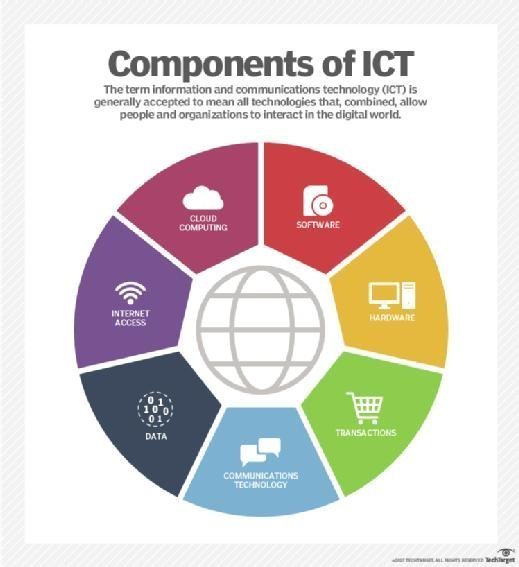What is ICT (information and communications technology)?
ICT (information and communications technology) is the infrastructure and components that enable modern computing. Among the goals of IC technologies, tools and systems is to improve the way humans create, process and share data or information with each other. Another is to help them improve their abilities in numerous areas, including business, education, medicine, real-world problem-solving, and even leisure activities related to sports, music and movies.
There is no universal definition of ICT because the technologies, devices and even ideas related to ICT are constantly evolving. However, the term is generally accepted to mean all devices, networking components and applications.
When combined, these help people and organizations interact in the digital world.
Organization is broadly defined to encompass businesses, nonprofit agencies, governments and even criminal enterprises, so virtually anyone can benefit from the proper application and use of IC technologies, devices and innovations.
What technologies are included in ICT?
ICT encompasses the internet, as well as mobile infrastructures powered by wireless networks. It includes antiquated technologies, such as landline telephone, radio, television and broadcast -- all of which remain widely used alongside today's cutting-edge ICT components, such as smartphones, artificial intelligence (AI) and robotics.
The internet, internet of things (IoT), metaverse, virtual reality and social media are also part of ICT, as are cloud computing services, video conferencing and collaboration tools, unified communications systems and mobile communication networks. Newer technologies, such as 5G, 6G, Web3 and quantum computing, are also part of the ICT universe.
Any technology, infrastructure, component or device that enables communications, data sharing and global connectivity between humans and between humans and machines may be considered as part of ICT.

ICT vs. IT
ICT is sometimes used synonymously with IT. However, ICT generally represents a more comprehensive list of components related to computer systems and digital technologies.
IT is more about managing the technologies related to information and its various technical aspects, including software, hardware and networking. IT management does not include considerations of telecommunications devices and technologies, while ICT does. IT can be considered a subset of ICT.
What are the components of ICT?
The list of ICT components is exhaustive and continues to grow. Some components, such as computers and telephones, have existed for decades, while others, such as smartphones, digital TVs and robots, are more recent entries.
ICT components include the following:
- Devices (hardware).
- Software.
- Middleware.
- Data.
- Wired networks.
- Wireless networks.
- Computer networks.
- Communication technologies.
- Cloud entities and services.
- Communications protocols and interfaces.
- Information security and information governance policies.
ICT means more than its list of components; rather, it encompasses the application of all the various components. That combination presents the real potential, power and danger of ICT for economic, societal, and interpersonal transactions and interactions.
Why ICT is important for businesses
For businesses, advances within ICT have brought a slew of cost savings, opportunities and conveniences, including the following:
- Highly automated business processes that have cut costs.
- The big data revolution, where organizations are turning the vast trove of data generated by ICT into insights that drive new products and services.
- ICT-enabled transactions, such as internet-based shopping, telemedicine and social media, that give customers more choices in how they shop, communicate and interact.
Challenges ICT creates
Its many benefits notwithstanding, ICT has also created problems and challenges for organizations, individuals and society. The digitization of data, expanding use of high-speed internet and growing global network together have created new opportunities for crime.
Increasingly, bad actors take advantage of these opportunities to hatch new schemes to gain unauthorized access to enterprise or government information systems. They do so to steal money, intellectual property or private information. Many cybercrimes are also aimed at disrupting systems that control critical infrastructure and, ultimately, creating widespread chaos and panic.
Developments in ICT have also brought new automation technologies and robots that sometimes displace workers, especially workers involved in repetitive, low-value tasks. In some cases, ICT has resulted in more people limiting their face-to-face interactions with others, creating or exacerbating social issues, such as trolling, cyberbullying, isolation, loneliness and depression.
ICT, the digital age and digital divide
ICT has drastically changed how people work, communicate, learn and live. It continues to revolutionize all parts of the human experience, as computers and now robots do many tasks humans once handled.
ICT's importance to economic development and business growth has been so monumental that it's often credited with ushering in the Fourth Industrial Revolution. ICT also underpins broad shifts in society, as individuals en masse are moving from personal, face-to-face interactions to relationships that take place in the digital technologies space.
ICT capabilities aren't evenly distributed for all its revolutionary aspects, with richer countries and individuals enjoying more access to ICT. These entities are better able to seize the advantages and opportunities offered by the use of ICT. This discrepancy in access to ICT has created what is now known as the digital divide.
Numerous governmental authorities and nongovernmental organizations advocate policies and programs that aim to bridge the digital divide by providing greater access to ICT among those individuals and populations struggling to afford it.
The impact of artificial intelligence on ICT
Many technologies associated with ICT have existed for years, such as telephone systems and networks. Others, such as cloud technology and IoT, are more recent but no less important. The advent of AI and its rapid adoption across all aspects of ICT portend a significant future for all ICT.
Virtually every aspect of ICT is being positively impacted by AI. In short, AI makes everything associated with ICT better, faster, more efficient, more automated and more innovative. Among the areas in which AI is having a positive effect are the following:
- Network management improvements. Sophisticated network analysis algorithms can accommodate and adapt to unplanned anomalies that could disrupt network performance.
- Enhanced cybersecurity support. When used in cybersecurity, AI can examine a variety of network anomalies, determine the nature of the issue, and either present recommendations to fix the problem or automatically address the issue with minimal human intervention.
- Intelligent maintenance. By regularly communicating with ICT elements, AI can assess how well a device, software or network system is performing, whether it needs updating or a patch and whether it is potentially at risk of failing. The system can also advise how and when to address maintenance issues.
- Task automation. Routine activities, such as network monitoring, running remote diagnostics and even threat hunting, can be automated, freeing up technical teams for other more complex tasks.
- ICT performance data analytics. AI can capture and analyze vast amounts of ICT performance data to deliver recommendations for improving performance, preemptive advice on potential disruptions and actionable information.
- User experience enhancements. By understanding user requirements and behavior, AI can develop personalized content, such as access to specific functions and specialized reports.
- Resource optimization. Using performance data from various ICT elements, AI can optimize network bandwidth, data storage and other resources based on demand and utilization requirements.
- Service innovation. AI can use ICT resources to develop advanced applications, such as smart homes, smart automobiles, and IoT products and services.
Clearly, the future of ICT will be greatly enhanced through the use of AI and related technologies.
Explore how IT leaders drive the evolution of digital transformation, and explore digital transformation benefits for business.






